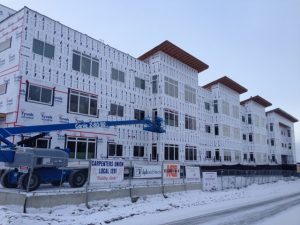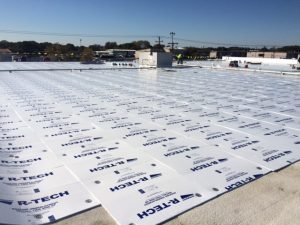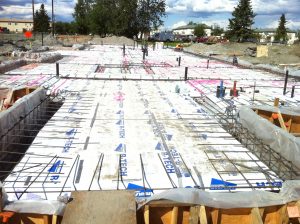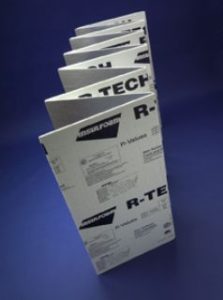Understanding Continuous Insulation (CI)
What is Continuous Insulation?
Continuous insulation (ci) (as defined in ASHRAE 90.1, Energy Standard for Buildings Except Low-Rise Residential Buildings):
“Insulation that is continuous across all structural members without thermal bridges other than fasteners and service openings. It is installed on the interior, exterior, or is integral to any opaque surface of the building envelope.”
Why Continuous Insulation?
Wood and steel studs, joists and other framing members make-up a large portion of any wall, and provide a path for hot or cold air to escape which reduces the energy efficiency of a building. (This heat transfer is also known as “thermal bridging” in the building science community.) Insulation does not allow the same air transfer as steel and wood framing does, therefore adding a layer of ci over framing (studs and cavities) assists in boosting the thermal performance and energy efficiency of the building envelope. Building owners benefit through reduced heating and cooling energy costs.
Since 2012 the International Energy Conservation Code (IECC) has required continuous insulation in the building envelope in most all Climate Zones (as defined by ASHRAE 90.1). To help improve the energy efficiency of buildings, the 2012 IECC has specifically prescribed how much insulation is required for various types of above grade walls, below grade slab & walls, roofs and floors, within each of the 8 U.S. climate zones – for both commercial and residential buildings.
In addition to enhancing a building’s energy efficiency, CI helps reduce moisture damage in the building envelop by lowering condensation within the envelope assembly resulting from vapor diffusion.
Determine the right amount of ci with ASHRAE’s climate zone map, and prescribed ci requirements per zone, click here.

Per requirements, CI is installed on exterior walls

R-Tech Fanfold Roof Insulation
Continuous Insulation Options Using Rigid Foams

EPS insulation in an under-slab application
The most commonly used CI options are rigid foam insulations:
- Expanded Polystyrene (EPS)
- Graphite Polystyrene (GPS)
- Extruded Polystyrene (XPS)
- Polyisocyanurate (Polyiso)
Among rigid foam insulations, EPS and GPS have the highest R-value per dollar, which makes them well-suited for cost-effective continuous insulation. EPS, such as Insulfoam EPS and R-Tech branded products, is a rigid and tough, closed-cell foam that provides about R 4.6 per inch of thickness. Due to the way it is made, unlike other rigid foam insulations, EPS retains its R-Value throughout its time in service. EPS is the most versatile of rigid insulations because it can be used anywhere in the building envelope – roof, walls, floors, and below grade since it dries quickly and assists with moisture management requirements.
Insulfoam’s R-TECH is an engineered rigid insulation consisting of a superior closed-cell, lightweight and resilient EPS with advanced polymeric laminate facers. It is made with factory-adhered facers that provide superior insulation, durability and protect against moisture.
GPS, graphite-infused polystyrene, insulation provides R 5 per inch of thickness. It combines factory laminated specially-treated metalized polymeric facer and premium insulation into one product, creating a semi-vapor permeable (breathable) shield to efficiently meet the latest building and energy code requirements for continuous insulation.
Mostly used in walls or below grade applications, XPS provides about R 5 per inch of thickness, and is mid-range in price between EPS and ISO. Although XPS is slow to absorb moisture, it is also slow to release it, which can reduce the insulation’s effective R-Value as it retains moisture over time. Most XPS manufacturer warranties reflect this R-Value decline and only warrant 90% or less (warranted percentages also decrease over time) of the product’s thermal value.
Historically polyiso was used in roof assemblies, although some manufacturers now offer wall insulation. Polyiso panels provide up to R 6.5 (aged value) per inch of thickness. Polyiso R-Values start at about R-7 per inch, but (like XPS) degrade over time as the thermal-enhancing blowing agents used to make them diffuse out of the material. Polyiso thermal warranties also reflect this R-Value decline.
Using Insulfoam products to reduce CI labor and material costs

EPS Fanfold
Insulfoam offers its EPS and GPS products in a range of options that help building teams reduce their continuous insulation labor and material costs. For example, large InsulFoam and R-Tech panels are available to minimize seams, and speed insulation. R-Tech insulation is available in “fanfold” bundles made-up of 25 or 50 two-foot by four-foot panels, with each panel attached to its neighbor along one side. The bundles weigh less than 11 pounds each, so it is easy for one person to carry two bundles. Two bundles easily unfold to cover up to 400 square feet per at one time.
R-Tech fanfold bundles require fewer fasteners than other roof and wall insulations, and require about 60% fewer man hours to install than working with individual insulation sheets. As a result, roofers specifically can save up to $25 per square – or about, $12,000 on a 500 square (50,000 square foot) roof. The bundles also help speed insulation in below grade applications.
Insulfoam’s Total Wall system takes ci a step further and integrates weep channels into the core of the R-Tech product, offering a product that is ideal for stucco and EIFS structures.

